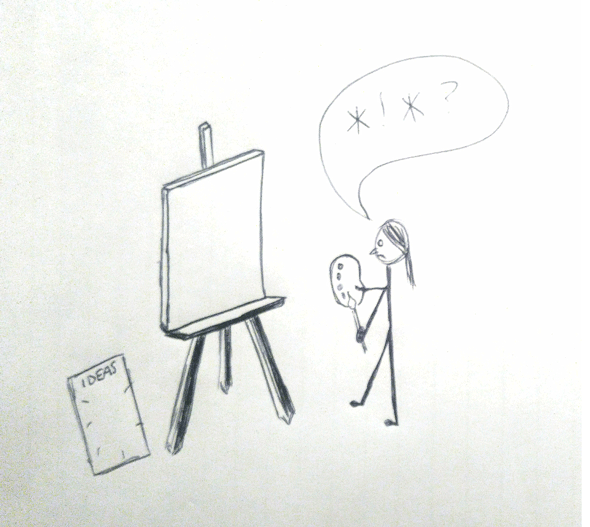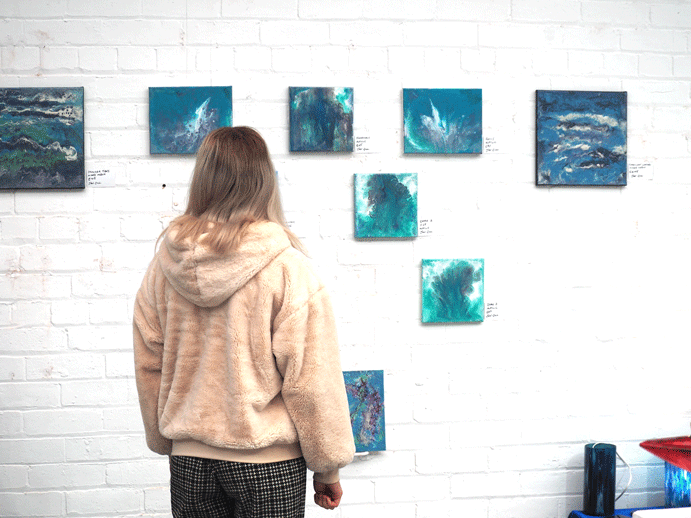Hello white canvas, goodbye inspiration.
You’re staring at it again. Palette ready, brushes clean, interruption free time guaranteed.
And…. nothing.
Drawing a blank.

Yesterday you knew exactly what you were going to do, but now you’re not so sure. Is it really a good idea?
The deadline is looming closer and you need some great work for that exhibition.
Dive into these 31 inspired tactics to get you off the starting block. Some are tried and tested, some are fresh new angles, all are going to help you get where you want to be.
1 Splash it on all over! You wouldn’t start a gym session without a warm up, so get yourself going with a fun loosening up session. Get a big brush with weak runny paint and just slosh it around. Use your favourite colours and have some fun. Don’t think it, just feel it. When the surface is covered take a good look. See which passages attract your attention. Take a photograph if you like and save it for a mood board. The more you do this, the better the results get. Just remember to really let go and have no preconceived ideas.
Splash it on, watch it dry.
2. Change your routine. Complete things in a different order. Get in your studio first, before breakfast and coffee. Break the cycle to beat the block before your head catches up. Prime your sleep by doing something creative before bed or watching a couple of youtube demos.

3. Indulge yourself with a treat. Have some of your favourite food or drink. This releases chemicals in your brain that make you happy and more relaxed, a much better place to work from than grumpy and tense.
4. Create for yourself. Make something just for you. Not for selling, not for exhibiting just for your own enjoyment. It’s much easier to get started when there are no restrictions.
5. Scream! Go on grab a lungful and let it go. Release all that anger and frustration in the biggest bellow you can muster. Now doesn’t that feel better? Careful, this can get addictive :-). If anyone asks what’s going on, tell them it must have been the TV.
6. Change your Medium. Always work in watercolour where you need to plan for battle? Work in acrylics where you can alter as you go along. Oils your got to paints? Work with dry media where you don’t have to wait forever for it to dry.
Use a different Medium

7. Get out. Take a trip on public transport with a pencil and pad. Do quick sketches of what you see. Add notes about colours, textures, shadows. take photos of anything that really grabs your attention. Look for surprising details in the mundane.
8. Tack against the wind. Don’t try moving forward in a headwind by facing into it, take a shallower path keeping the prize in your peripheral vision. Do something different for half an hour. Go shopping, buy gifts, look at magazines, do something that scares you. Art and design is all around you so immerse yourself in it to encourage your muse.
9. Handle your media. Don’t paint, just handle your tubes, brushes, paper, whatever. Notice the colours, textures, smells and feel of them. Organise them if it makes you feel better. Establish that link with your pleasure centre.
10. Work Outside. Take your kit in the garden or to the park or even the beach and paint or sketch. Feel the breeze, smell the air and listen to the sounds. Make a quick impression of your surroundings or write about what you see and feel. Keep the pages to remind you ready for the days when you can’t get out.
11. Visit a Museum. Have a wander round, then recall the one thing that attracted your attention. Go back and sketch it. This way you are learning about what moves you and what you might invest in emotionally.

12. Go to an art material shop. Investigate what’s new. See what inspires you. Is there something new you’d like to try? Find out what excites you.
13. Do something boring. Do something that bores you. Complete a chore. Sort that pile of unpaired socks. Maybe that’s just me then :-). Allow your mind to start wandering — it will want to do something and that may well be a creative idea.
14. Watch paint dry. No, seriously. Use puddles of paint on a flat surface, drip colours in, move from side to side, add water, alcohol or thinners and just watch it move around. Get your camera out and photograph it when you like an effect. Watch as it changes and let the inspiration flow.
Watching paint dry!

15. Play with children. Children are fearless. Get them creating and they will experiment in ways you’d forgotten you could dream of. Their fun is infectious too. No kids? Borrow some from the neighbours, they’ll thank you for it :-)
16. Stop looking for perfection. Mistakes are just “happy accidents”. Go with them and adapt. It may glare at you but nobody else will even know. I’m not suggesting getting sloppy here, but we are often our own worst critic.
17. Go to an exhibition. Bear with me, this is more than the obvious. Find a painting that grates with you somehow. Work out why it does that. Is it the subject, the composition? Could you think of a better way of completing the work? This exercise helps in 3 ways. It shows you that not everything is perfect, gets your analytical and critical brain working, and awakens inspiration.
18. Get your photo albums out. Look for inspiration in the things you thought worthy of capturing and printing. It’s easy to forget all those years of experiences and these are things you are emotionally invested in. Use that emotion as a wellspring of inspiration.

19. Review your past successes. Nothing breeds success more than success. Don’t think you have to create something new from scratch all the time. Artists down the centuries have repeated the same theme over and over. Each time they learned something new. Each time they brought the extra experience to bear on the subject. Monet, Cezanne, Rembrandt, Da Vinci to mention a few, all reprised their work, so you will be in truly great company.
20. Fill up your senses. Take a sensory break stimulating all your senses. Put on some music, scented candles, soft light stroke the cat and enjoy a cuppa. Keep the sensual stimulation going to the studio, just don’t put your brush in your tea instead of the water!
21. Daydream. This is a kind of meditation technique. Direct your daydreams by imagining being in a hot air balloon floating over meadows full of flowers, the perfume on the breeze. The comforting humming of bees, the taste of honey. Where are going, what comes next? Follow your path and find your muse.
22. Change the Subject. We all have a few favourite subjects we like to paint. Why not try a different one. Be brave and step outside your comfort zone. Not only will you learn something new, but you will feel amazing when you smash it.

23. Stand on the Shoulders of Giants. One of the first things apprentice artists in the classic system of learning were instructed to do was go out and copy the greatest works in galleries and museums. You have probably heard this over and over. Have you ever done it? Sorry, but reproductions are not good enough for this. There is a whole dimension you are missing out on.
24. Cross Pollinate. Gardeners cross pollinate to grow better plants making them more resilient, larger, more desirable to eat or even more colourful. Mix up creative genre to generate ideas in each. How can you use what you know from photography to inform your art for instance. The camera shows a different perspective that you can use creatively, for example, freezing motion to capture things that happen too fast for the naked eye.
25. Mix Media. Using a variety of media can bring out some very surprising results. It can add interest and texture and enable you to create your vision when it’s impossible with just one medium.

26. Accept a challenge. Magazines and forums often challenge their readers to work towards a particular goal or theme. Look up and join in a few. The ideas may take you where you have never thought of going and you get to share that with a whole bunch of other creatives. It doesn’t have to be a solo expedition.
27. Doodle. Create big expansive doodles and keep coming back to them, or little corners of your shopping list. Keep a pad at your side while you watch TV and do some more. You may find some interesting results but you will also be using that creative muscle.
28. Mindful Mandalas. These are all the rage and you can find them everywhere, on the internet, in the supermarket at the library. Tone your creative muscle while creating in a way which is both meditative and mindful. Notice the colours you choose and the effects they create next to each other.

29. Catch your Dreams. Have a pad and paper by your bed. Write down the dreams you remember or the first things that come into your head. Put in as much information as you can, especially feelings and surroundings. Some may be strange, surreal or downright crazy but you will be accessing your imagination and bringing something unique to the creative table.
30. Brainstorm Titles. Spend 15 minutes each day, maybe over your morning coffee, just thinking of titles for paintings. Open a dictionary and find new words you could use. Find interesting titles other artists have used. Consider song lyrics or poems to start from. Do this every day and you will soon end up with a vast list of ideas to inspire you.
31. Have a painting Party. There is nothing like the company of peers to spark ideas. Start a painting each then pass it along for the next person to continue. It’s fun and an icebreaker. Or start one big canvas together. Last one to start gets the drinks in! Make it fun and it’s amazing what you can learn. If you use acrylics, you can even paint over everything and reuse the canvas. Photograph it first though :-)
Follow these tips however you like. Choose one for each day, or add some to your daily routine (recommended!) and you will soon find that you are not only improving your store of ideas, but building creative muscle memory too.
Next time you are preparing for that exhibition, you will have a stock of ideas and creative solutions at your fingertips. You’ll need less time to paint each picture as your creative muscle jumps into action.
You will look forward to that fresh new canvas knowing that you will be able to use your interruption free time to it’s fullest.
I'd love for you to come back and share your results with us.
Have you got any tricks you turn to for getting back in the groove?
Why not share them in the comments :-)